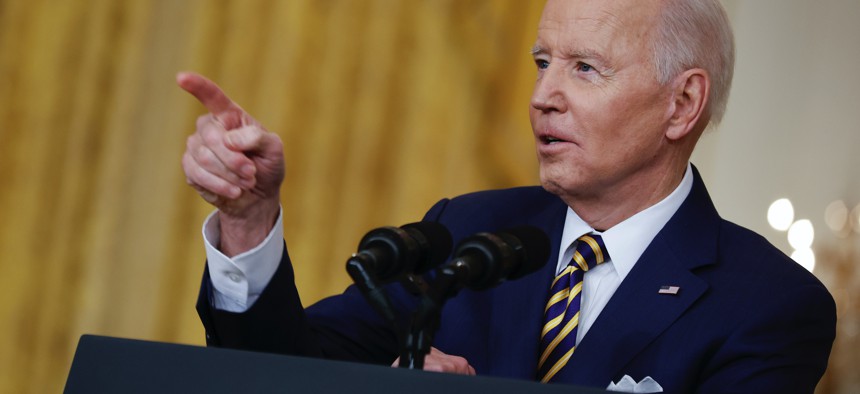
U.S. President Joe Biden answers questions during a news conference in the East Room of the White House on January 19, 2022. Chip Somodevilla/Getty Images
Biden’s Gray-Zone Gaffe Highlights a Real Dilemma
It’s high time for NATO and its member governments to define what kinds of aggression short of war require a unified response.
This week, President Biden inadvertently highlighted a defender’s dilemma: no country or alliance has yet mustered an effective strategy for responding to gray-zone aggression, which can range from disinformation campaigns to weaponization of migrants to tools aggressors might yet think up. Yes, drawing attention to this dilemma was unnecessary—but its existence requires urgent attention.
It was one day short of the celebratory first anniversary of his presidency that Biden was asked yet again about a potential Russian attack on Ukraine. Ordinarily, politicians answer such questions with vague threats of serious repercussions; indeed, Biden has done so many times. This time, too, he vowed that Putin would pay a "serious and dear price" for invading Ukraine. Then he went on: "What you're going to see is that Russia will be held accountable if it invades and it depends on what it does. It's one thing if it's a minor incursion, and then we end up having to fight about what to do and not do etc."
Biden alone knows why he decided to lay bare NATO’s weakness in such eye-catching fashion, and White House spokeswoman Jen Psaki hurriedly sent out a statement to “clarify” the U.S. stance. If any Russian military forces move across the border to Ukraine, Psaki said, America and allies will respond swiftly and severely. She added: “The Russians have an extensive playbook of aggression short of military action, including cyberattacks and paramilitary tactics. And [Biden] affirmed today that those acts of Russian aggression will be met with a decisive, reciprocal, and united response.”
That’s not exactly what the president said, of course. On the contrary, he said that in cases of aggression below the threshold of armed conflict, NATO’s member states disagree about how to respond. Indeed, many of the individual governments of NATO member states would be internally divided on the matter.
To be sure, it may seem common sense that a “minor incursion”—featuring, say, a few people dressed as Ukrainian police officers who take possession of a police station in the border area—should somehow be countered. But by whom? Would it be a task for law enforcement? The Ukrainian armed forces? The U.S. military and other NATO forces? And if Ukraine and its international friends decided that such an activity warranted a military response, what about other activities below the threshold of armed conflict? Is moving a border just a tiny bit, what Georgians call borderization, a casus belli, or is the loss of a few meters of land simply an annoyance? China, meanwhile, can keep punishing countries it wishes to harm by surreptitiously suspending imports, and no military arsenal can frighten it into refraining from such outrageous behavior.
It would be ridiculous to punish economic coercion with military means, you say. If one decides, though, that some activities below the threshold of war warrant a military response, that involves setting a new threshold. In my book The Defender’s Dilemma, I propose that loss of life could be such a threshold; remember that cyber attacks on hospitals, for example, can claim lives. (In 2019, NATO added “serious cyber attacks” to its causes to invoke Article 5, but what constitutes a serious cyber attack? An attack on an assisted-living facility that claims the lives of 10 extremely elderly residents? 100? A knockout of a country’s grid?)
Today, though, no alternative threshold exists. Some NATO member states such as Latvia are developing partial total-defense models that prepare the public for troubles below the threshold of war. Were mysterious police officers to turn up in a remote Latvian location, it’s likely that high-schoolers recently trained in societal resilience would spot something unusual and report the coordinates to the government. But for unified NATO action to take place in response to gray-zone aggression, member states have to agree in advance on what constitutes the threshold that will trigger a response. They would then be able to communicate their agreement to the outside world so that Russia, China, and any other hostile-minded regimes would know to expect a coordinated response. Ideally, such deterrence messaging would change their cost-benefit calculus and they’d refrain from the aggression.
Telling the world that no such agreement exists was an unwise move by Biden, but nobody would suggest it’s news to Russia. The answer can only be for NATO member states and their partners to decide what’s going to constitute their threshold. If it’s not going to be an armed attack, including a serious cyber attack, what’s it going to be? Then they need to keep reminding the world what the new threshold is and the magnitude of the response it’s going to trigger. If they do so, it may just convince attack-minded countries that an attack will bring more cost than benefit. Deterrence begins long before the prospective punishment.
NEXT STORY: Slouching Towards Armageddon




